Short Haired Cats:- Greatly varied in characteristics, as breeders will demonstrate, shorthaired cats probably descended from early Egyptian small fur domesticates.
Their coats probably varied according to climatic changes, such as developing thinner, longer, less dense coats to keep cool in warmer temperatures.
Some feline furs have a sleek, smooth coat (Siamese and Burmese,) while others possess an undercoat (Abyssinian, Chartreux, and Manx.) Short fur Cats may require less grooming, but general care is similar to that of longhaired cats.
Read More
Short Haired Cats Breeds
Short Haired Cats | From (A to C)
American Bobtail

The American Bobtail originated in the 1960s quite inadvertently. This breed is a short-tailed cat with a thick, semi-long coat.
This cat’s personality is said to be similar to a dog’s. They enjoy interacting with their family and are playful, yet docile. This breed is domestic, but its physical characteristics give it a wild appearance.
American Curl
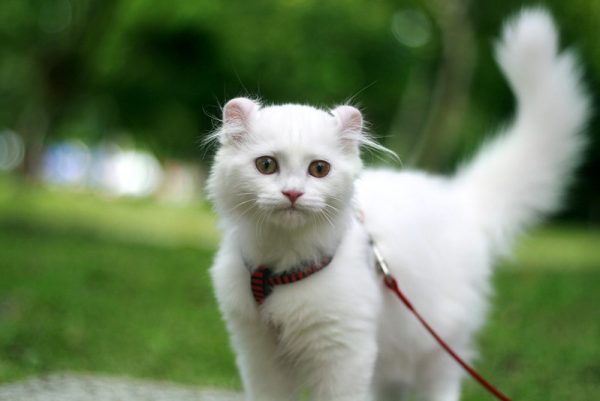
The American Curl is a new breed that is distinguished by unique ears that curl back in an arc. All American Curls trace their origin back to one cat named, “Shulamith.”
The cat produced two curled-ear kittens in her first litter. It was later determined that this was a genetic trait and the American Curl is now recognized as a native breed of the United States.
American Shorthair

The American Shorthairs’ relatives came from Europe on the Mayflower and with other early pioneers to North America.
These cats were considered working cats that helped control rat populations when rats would eat the pioneer’s food supply and pass on diseases.
Today, this breed makes a gentle companion that enjoys children and being part of the family. The American Shorthair is known for its long life and robust health.
American Wirehair

The American Wirehair is the result of a spontaneous mutation in farm cats in 1966. A kitten was born with a hard, wiry coat, which was unlike either of its parent’s coats.
This American breed is resistant to disease and easy to care for. They are quiet and reserved, yet loving.
Australian Mist

As its name indicates, this breed originated in Australia. It was developed primarily using the Burmese with the Abyssinian and domestic shorthair.
The breed is lightly spotted and comes in a wide variety of soft colors. The Australian Mist maintained the loving personality of the Burmese and has its own unique charm.
Balinese
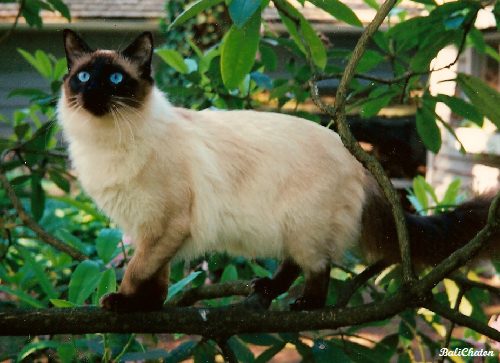
The Balinese are analogous to the Siamese except for coat length. The Balinese’s coat is long, where the Siamese’s coat is shorthaired.
The Balinese began to be bred in the 1940s. It is commonly accepted that the breed originated as a spontaneous longhaired mutation of the Siamese cat. The cat looks refined and majestic, but its personality is friendly and playful.
Bengal Cat

The Bengal Cat is an exotic breed that descended from a cross between wild Asian Leopard Cats and domestic shorthairs.
Many Bengals have an instinctive love of water and have been known to climb into the shower or bathtub.
Bengal cats are blessed with intelligence, playfulness, and affectionate nature. They also have excellent athleticism and leaping ability. Most pet Bengals are wild only in looks, not in personality.
Bombay Cat
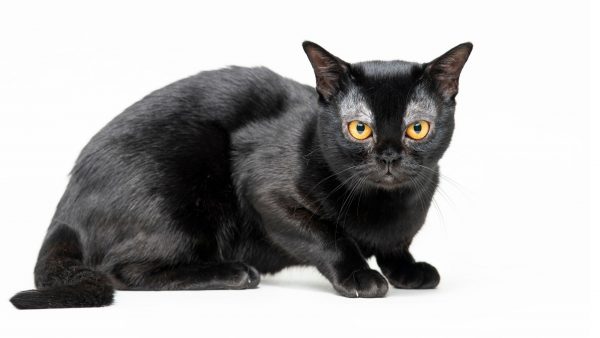
The Bombay began as a dream for Nikki Horner of Louisville, Kentucky in 1953. She spent years trying to breed a “mini-panther.” The Bombay’s coat is jet black to the roots.
Ms.Horner used a sable Burmese and black American Shorthair as the basis of the breed. The Bombay is the only cat that is judged 50% on color and coat. This breed is agile and intelligent. They can be leashed-trained and will fetch naturally.
British Shorthair

The British Shorthair is thought to have originated from the domestic cat of Rome and to be the oldest of the English breeds. Originally, it was esteemed for its strength and hunting ability.
Today, this breed is known for its calm demeanor and intelligence. This reputation has made it a favorite of animal trainers, for use in Hollywood films and television commercials.
Burmese
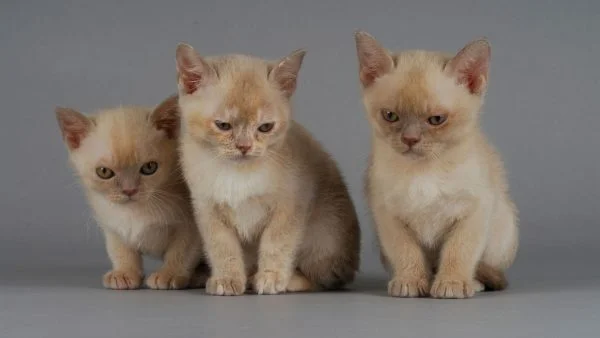
Dr.Joseph Thompson of San Francisco, California, acquired a walnut-brown female cat from Burma, which he then bred to Siamese cats.
Over time, the Burmese became a separate breed. They have distinct and powerful eyes that often endear people to them for life.
These cats have also been described as “bricks wrapped in silk,” because they are surprisingly heavy for their size, but have a satin-like coat. This breed is very people-oriented and loves to have the attention of its owner.
Burmilla
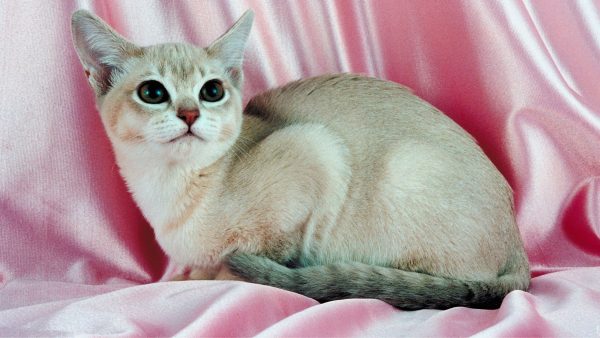
The Burmilla resulted from accidental breeding between a Chinchilla Persian named Sandquist and a lilac Burmese named Faberge. This litter was born in 1981 and the four kittens were the foundation of this breed.
Similar to their Burmese cousins, Burmillas are playful, friendly, and loving. The coat of the Burmilla is light with tips of the hair having a contrasting color.
California Spangled

A California breeder, who was determined to create a domestic breed that mimicked endangered spotted wildcats, developed the California Spangled Cat in the 1980s.
It took eleven generations and six different breeds to develop this wild-looking domestic cat. This breed is energetic and intelligent. It enjoys the company of the owners, but will not be too demanding of their time.
Chartreux

The Chartreux is considered a French breed, even though the exact origin of this cat is unknown. There are documents from the 16th century that speak of the Chartreux and its unique coat.
The breed often takes a full three years to reach maturity and has an adolescent stage between kitten and adult.
The Chartreux has a double coat that should not be brushed, but stroked by hand and then went over with a chamois.
Colorpoint British Shorthair
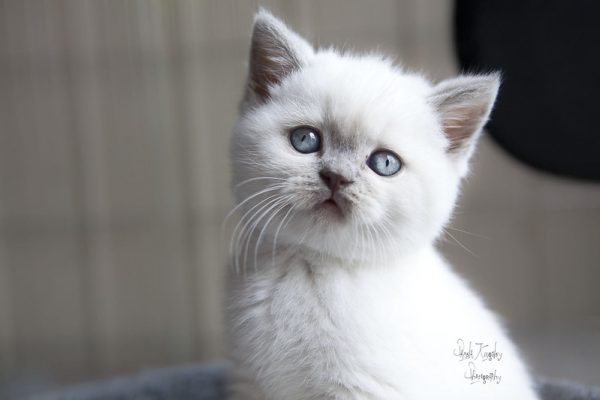
The Colorpoint British Shorthair is thought to have originated when the Romans invaded and ruled England for two thousand years.
Over the years, the cats bred among themselves. After World War II, the British wanted to improve the breed and began crossbreeding with Persian cats. Today its tranquil nature and distinctive appearance make this breed a popular pet.
Colorpoint European Shorthair
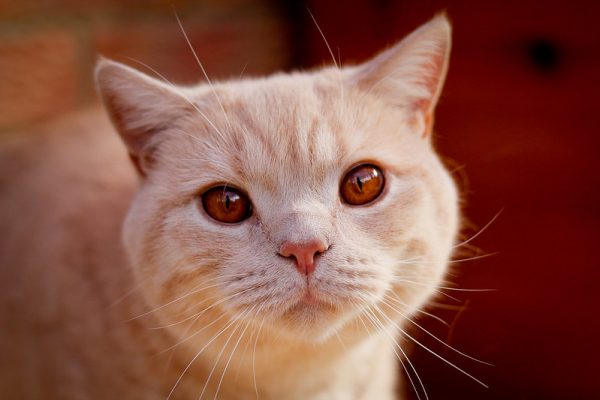
The Colorpoint European Shorthair is thought to have a similar development to the Colorpoint British Shorthair. They were developed in 1982 in Italy.
Breeders were able to give this breed a Siamese pointed coat pattern, without changing its disposition or physical build in other ways. This cat is active and adaptable to different situations.
Colorpoint Shorthair

The Colorpoint Shorthair is a relative of the Siamese, but they have many more colors. The breed can make a wonderful companion. These animals absolutely love attention.
They enjoy being groomed and tolerance is one of their many wonderful traits. The paler colors tend to be a bit shyer, but they still want to feel like they are a part of the family.
Cornish Rex

The Cornish Rex originated in Cornwall, England around 1950 in a litter of barn cats. The appearance of the Cornish Rex is not like that of an average cat.
These creatures have distinctive heads and body types. Some compare the body of the Cornish Rex to that of a Whippet dog, because of their arched back and long, thin legs. They also have a unique coat that is short and lies in washboard waves.
Short Haired Cats | From (D to J)
Desert Lynx Cat
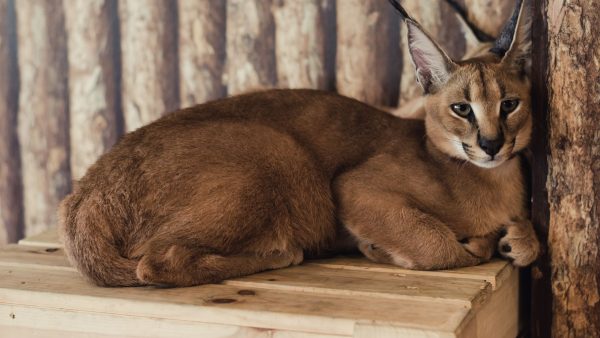
Desert Lynx Cats have many bobcats in their appearance because their gene pool contains the bobcat gene.
The breed appeared after mixing a bobcat with a domestic cat. These cats possess many features of their wild ancestors, such as ear tufts and neck ruffs, but they have stockier bodies and shorter legs.
They can be reserved with strangers, but very interactive and open with their owners. There are both long-haired and short-haired species.
Devon Rex

The Devon Rex is the result of a spontaneous mutation in barn cats in 1960 in Devonshire, England. They have large ears that poke out and away from their face.
The Devon Rex is said to be similar to a dog that will wag its tail when praised and follow you from room to room. This breed does enjoy playing but prefers to be a lap cat.
Domestic Shorthair
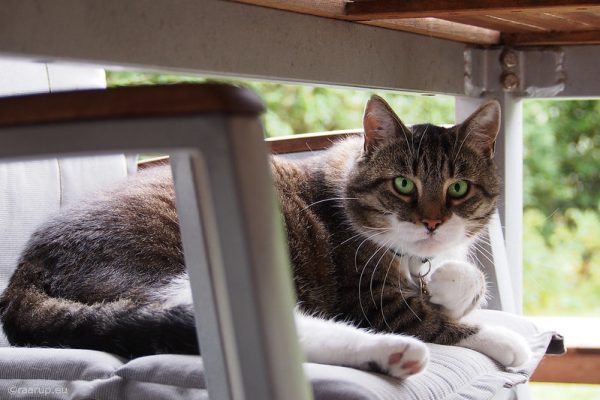
These Cats do not conform to any well-known standards, but they have greatly contributed to the formation of many valuable Australian breeds of cats, which have by now obtained Championship status.
They occur in a variety of colors and possess a very easy-going temperament combined with a high level of intelligence.
There is nothing extreme about Domestic Shorthairs, but they have firmly established themselves as the most common house pets in Australia.
Egyptian Mau

Due to its depiction in ancient Egyptian artwork, the Egyptian Mau is thought to be the cat that was domesticated from a spotted subspecies of the African Wild Cat.
The breed was held in the utmost respect. They were worshipped as deities, cherished as pets, protected by laws, and mummified and mourned at their death. The Egyptian Mau has an intense devotion to its human family.
European Burmese
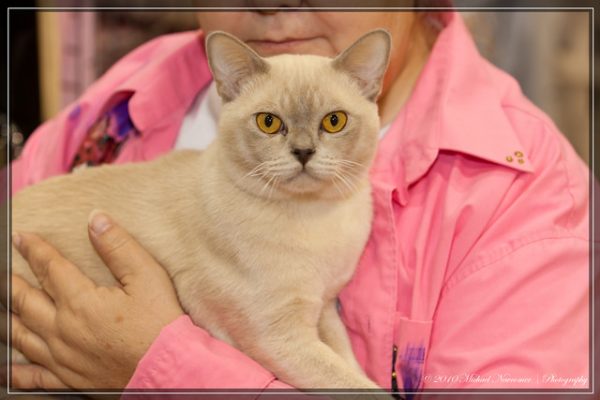
The European Burmese and the Burmese of North America originated from the same cat named, Wong Mau. Dr.Thompson introduced the first Burmese to the western world.
A red gene was introduced to the European Burmese; consequently, it has more colors than the Burmese of North America. The European Burmese makes a loyal pet and has a high intelligence level.
Exotic Shorthair

The Exotic Shorthair is a shorthaired version of the Persian cat. This breed comes in all colors and is more active and curious than the Persian.
The Exotic Shorthair is very responsive to humans and their emotions. These cats have a plush teddy look and the same type of squeaky voice as the Persian.
Havana Brown
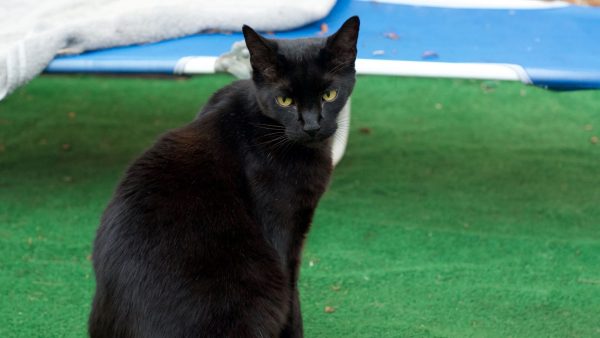
The Havana Brown is thought to have origins in the Royal Cats of Siam from South East Asia.
One of the first things you will notice about this breed is its shimmering mahogany-toned brown coat.
If you are ever wondering whether a certain cat is a Havana Brown, feel its muzzle. There is a pronounced break in the bone structure that all Havana Browns possess.
Japanese Bobtail
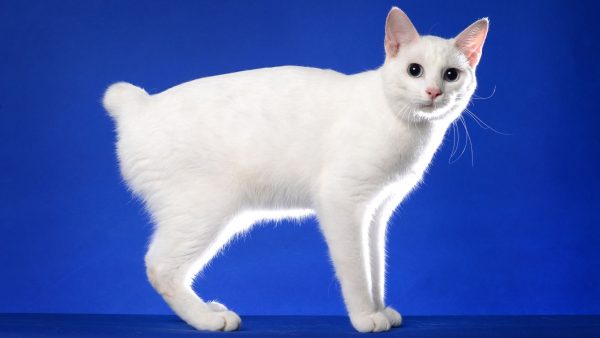
The Japanese Bobtail originated from domestic cats that came to Japan from China or Korea at least one thousand years ago.
Like a fingerprint, each Japanese Bobtail has a unique tail. No two are alike. This breed is also very talkative and proficient at a wide range of tones. These animals will almost always “talk” when spoken to.
Javanese

The Javanese is a Balinese with many color selections of the Colorpoint Shorthair. They were named after the next island over from Bali and they have existed as long as the Balinese.
The breed is very acrobatic and will display remarkable acts of athleticism. Intelligent, they will learn your routine and “remind” you when you are tardy with their meal or playtime.
Jungle Lynx
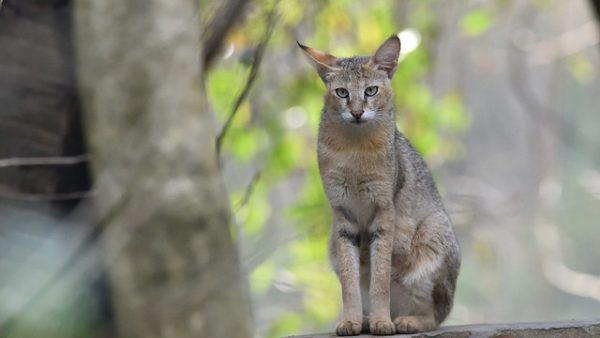
Jungle Lynxes are not recommended for novice owners, as they may be difficult to housetrain and control, but experienced and devoted owners claim these hunters be extremely affectionate and playful.
Since they are carnivores, don’t trust them with pets that would be their natural prey (birds, hamsters, sugar gliders, and other small animals.) Jungle lynx is a hybrid between the Jungle Cat and Bobcat, bred as an exotic pet.
Short Haired Cats | From (K to R)
Korat
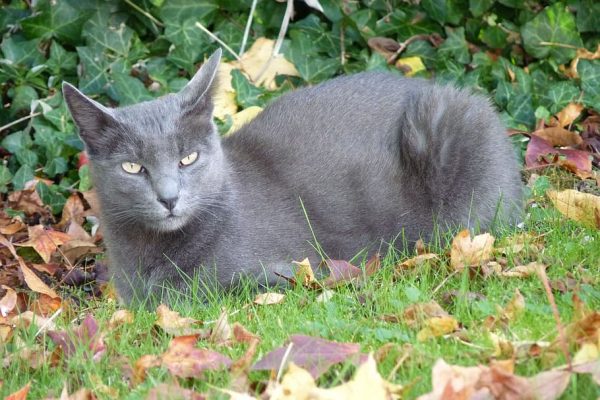
Korats have many good luck traditions that surround them. They are silver, which signifies wealth. They also have eyes the color of young rice, which means good crops.
The Korat originated in Thailand where they have been cherished for centuries. They make gentle pets, but enjoy having the upper hand with other cats.
Manx

The Manx is a tailless cat that originated as a working cat that is an extremely dedicated hunter. The Manx is the only cat that has been bred to be tailless.
These cats have mellow and calm personalities but are still loving and sociable. This breed has a distinctive trill that it will use to communicate with its young or respond to its owner.
Mixed Breed Cat

A mixed-breed cat is any cat that has more than one breed in its blood. Mixed breed cats make up more than 99% of the world’s total cat population.
Mixed breeds do have certain advantages over purebreds. Purebred cats or dogs are more prone to genetic problems.
If you adopt a mixed breed you have the benefit of more than one breed in the same animal.
Mojave Spotted Cat

Originally, the Mojave Spotted Cat was named the Mojave Desert Cat, and it was developed in order to save the feline, which lived in the Mojave Desert.
These cats are medium to large, weighing 8-22 pounds. They have very tightly muscled bodies, medium-long legs (the hind legs are longer), and short to medium-long tails (bobtails are permissible.)
The head is somewhat wedge-shaped, the ears are medium to large, and the eyes are almond-shaped.
Ocicat
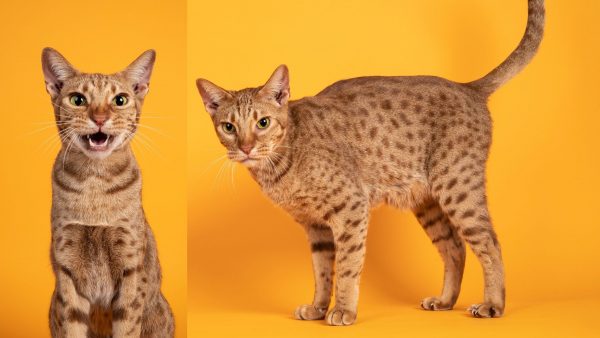
The Ocicat was bred to look like the spotted cats of the wild. These cats originated through breeding the American Shorthair, Siamese, and Abyssinian.
Although they look wild, their temperament is far from it. The Ocicat is much like a dog that enjoys the companionship of its owner, without being overly needy.
Oriental Shorthair
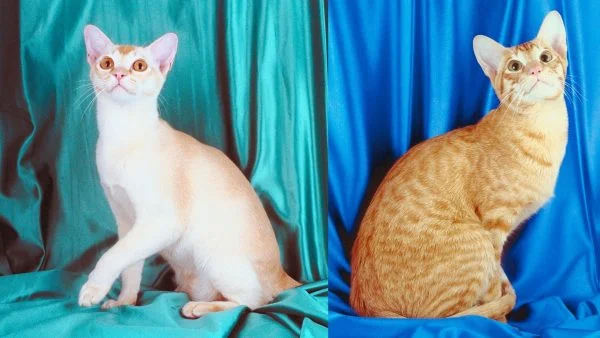
The Oriental Shorthair can be found in many types of colors and patterns. These cats are very similar to the Siamese in personality and body structure.
One nickname for this breed is “Ornamentals.” This name comes from the fact that they can be bred in over three hundred different patterns and color combinations. They are playful and talkative creatures.
Peterbald
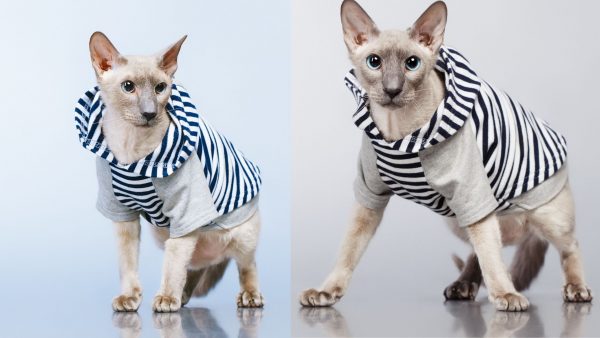
The Peterbald is the newest of the hairless cat breeds. These cats originated from the Russian Don Hairless, the Oriental, and the Siamese.
The Peterbald is not truly a hairless breed. Cats younger than two years have a wavy coat along any or all of their body and often this breed is only bald on the head, neck, and upper part of the back.
Pixie-Bob
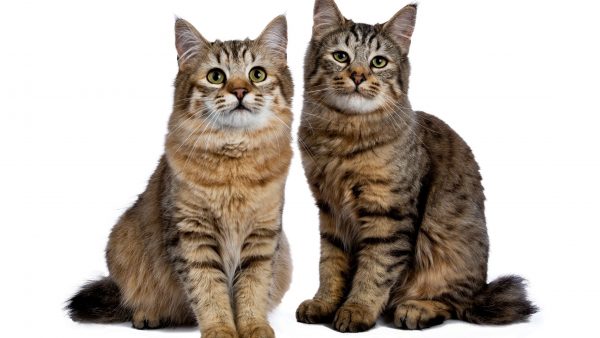
One of the most interesting things about a Pixie-Bob is that they are commonly polydactyl and the only breed that is accepted by any association that allows Polydactyly.
Polydactyly is generally known as being seven-toed, but it can be more or less. This normally occurs on the front paws. The Pixie-Bob is a loyal companion and an intelligent cat.
Russian Blue
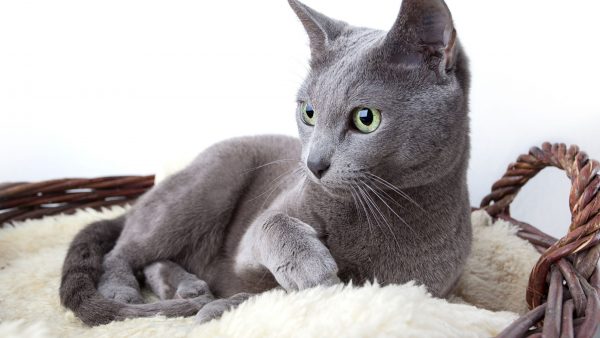
The Russian Blue is thought to have been brought by sailors to England and Northern Europe from the Archangel Isles in the 1860s.
Claims have also been made that they descended from the Royal Cat of the Russian Czars and that this breed was a favorite of Queen Victoria.
Their coat is very beautiful and easily distinguished from other breeds. It is a bright blue, with tips of the hairs being silver.
Short Haired Cats | From (S to W)
Savannah

The Savannah is a relatively new breed of spotted cats. These cats were bred to have the look of the rare African Serval. They were developed by crossing wild cats, in this case, the African Serval, to domestic spotted cats.
This breed possesses the wild beauty and grace of the Serval, but with the disposition of a domestic cat. Due to the difficulty in breeding and birthing, this breed is still relatively rare.
Scottish Fold

The Scottish Fold is the result of a spontaneous mutation. A Scottish shepherd named William Ross found the first Scottish Fold in 1961 and developed the breed from the original.
All Scottish Folds are born with straight ears and some will fold forward and downward at about three or four weeks of age. This breed has a quiet disposition but enjoys human company.
Selkirk Rex

The Selkirk Rex has a naturally curly coat and is one of the newest natural breeds. This breed originated from a house cat that was found in a Wyoming (United States) shelter.
This cat was bred to a black Persian that had a dominant mutation for curly hair. These curly-coated kittens are even born with curly whiskers. The Selkirk Rex is a tolerant and loving breed.
Siamese

The Siamese originated in Siam, which is the Thailand that we know today. This breed is thought to be the oldest or one of the oldest cat breeds in the world.
The cat is renowned for its amazing voice. The Siamese communicates like no other and has enthralled people all over the world. These cats love companionship with their family and will not be ignored.
Singapura
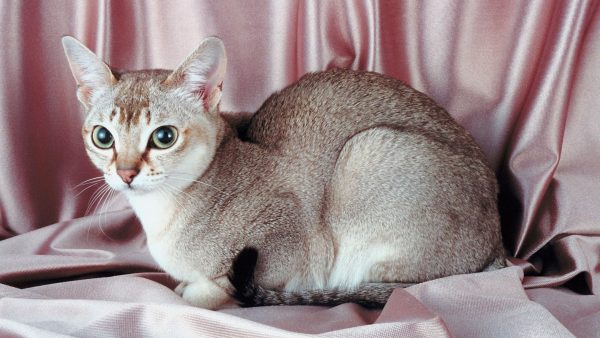
Singapura is a rare breed that originated in Singapore from a native cat. This breed has a distinctive appearance and is very small.
This breed is very active and will only be happy if it receives proper attention and is able to be a close part of your life. They even like to sleep under covers in your bed.
Snowshoe Cat

The Snowshoe Cat resulted from crossing a Siamese cat and a white Domestic Shorthair. Their origin can be traced back to Philadelphia, Pennsylvania in the 1960s.
Dorothy Hinds Daughtery’s two Siamese cats produced three kittens that had white feet. This breed is people-oriented and does not like to be left alone for long periods of time. These cats even like running water.
Sokoke Cat

Sokoke cats, also known as African shorthairs, have a distinctive African tabby-like pattern with a small head, defined cheeks, almond eyes, and erect slightly rounded ears.
The breed’s origin is unknown (perhaps a cross between African wild and domesticated cat.) Sokokes are one of the rarest breeds in the world.
Non-aggressive, independent, self-assured, prideful, and intelligent, characterizes this cat. It forms close bonds with humans and is very sensitive to the mood of the owner.
Sphynx

Mother Nature produced the Sphynx when a domestic cat gave birth to a hairless kitten in 1966 in Toronto, Canada. These cats actually have a fine down on their body that can be described as peach fuzz.
Their skin feels warm and has a texture similar to suede. Because of their lack of hair, they like to snuggle up to another animal or human and enjoy sleeping under your bed covers.
Tiffanie
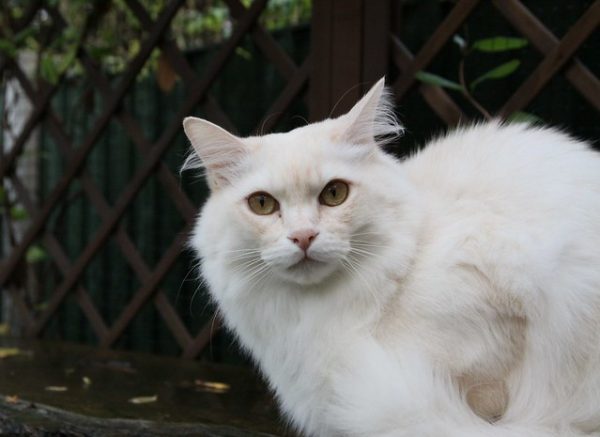
A Tiffanie is known as the semi-longhaired variety of the Asian group. This cat should not be confused with the American Tiffany, known as the Chantilly-Tiffany, which is a different breed.
The Tiffanie’s coat is fine and silky, and they have a ruff around their neck and longer fur on their tail. They do make good family pets, as long as you have time to groom their coat daily.
Tonkinese
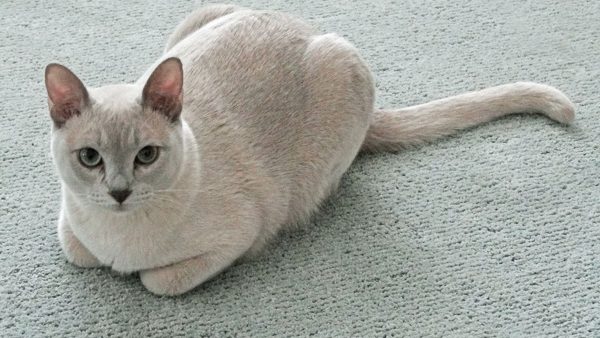
The Tonkinese was developed primarily using the Burmese and the Siamese. This breed has a colorful personality and thinks that a human’s only job is to love these cats.
They will greet your guests at the door and make it their personal goal to keep them entertained. They also have a high level of intelligence and a great memory.
Traditional Siamese

The Traditional Siamese’s body structure is slightly different from the show Siamese that we know today. Its body type is similar to the Tonkinese.
Most breed registries do not recognize the Traditional Siamese as a separate breed from the Siamese.
Like the Siamese, this breed is talkative and affectionate. Its coat colors are the traditional blue, chocolate, seal, and lilac point colors.
Wild Abyssinian
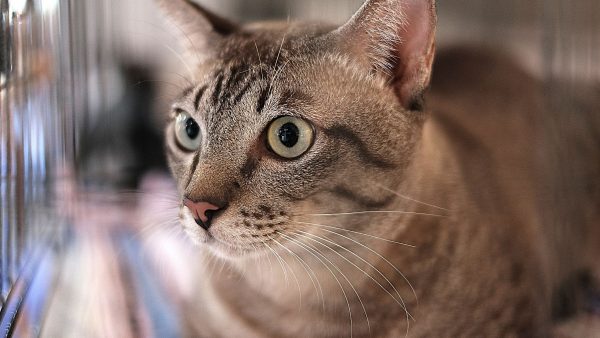
Contrary to what its name indicates, the Wild Abyssinian is not a wild cat. However, it was developed from feral cats in Singapore.
This breed came about when Italian breeders tried to bring back the Abyssinian to its original version. This shorthaired cat has bands on its legs. They are friendly, yet independent cats.